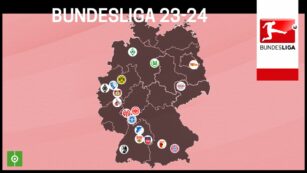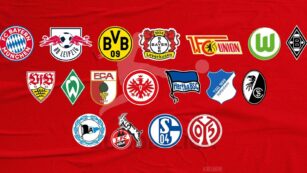Germany’s Bundesliga isn’t just a football league; it’s a vibrant tapestry of culture, history, and fierce rivalries. Each team carries the pride of its city, creating a unique blend of local flavors and national passion. Understanding the geographic spread of these teams offers fans a deeper appreciation of the league’s rich diversity. From the bustling streets of Berlin to the scenic landscapes of Bavaria, the Bundesliga map highlights the varied regions that contribute to the league’s dynamic atmosphere. Whether you’re a die-hard supporter planning your next stadium tour or a curious newcomer, this guide will help you navigate the home grounds of Germany’s top football clubs.
Map of Bundesliga Teams
 The Bundesliga covers diverse cities across Germany, each hosting a team with deep-rooted local pride. From Hamburg in the north to Munich in the south, teams offer a varied and colorful football experience. German football operates systematically, with clear distinctions between its leagues. The Bundesliga is the top tier, housing 18 elite teams. Below it, the 2. Bundesliga and 3. Liga function as the second and third tiers, respectively. The Bundesliga runs from August to May, with each team playing 34 matches, comprising home and away games against every other team in the league. Promotion and relegation connect the different tiers, ensuring competitive balance and opportunities for lower-tier teams to rise. The Bundesliga enjoys immense popularity both domestically and internationally. It averages over 43,000 attendees per match, the highest among Europe’s top leagues. Television broadcasts reach over 200 countries, highlighting its global appeal. Teams like Bayern Munich and Borussia Dortmund have massive fanbases, contributing to the league’s vibrant atmosphere.
The Bundesliga covers diverse cities across Germany, each hosting a team with deep-rooted local pride. From Hamburg in the north to Munich in the south, teams offer a varied and colorful football experience. German football operates systematically, with clear distinctions between its leagues. The Bundesliga is the top tier, housing 18 elite teams. Below it, the 2. Bundesliga and 3. Liga function as the second and third tiers, respectively. The Bundesliga runs from August to May, with each team playing 34 matches, comprising home and away games against every other team in the league. Promotion and relegation connect the different tiers, ensuring competitive balance and opportunities for lower-tier teams to rise. The Bundesliga enjoys immense popularity both domestically and internationally. It averages over 43,000 attendees per match, the highest among Europe’s top leagues. Television broadcasts reach over 200 countries, highlighting its global appeal. Teams like Bayern Munich and Borussia Dortmund have massive fanbases, contributing to the league’s vibrant atmosphere.
Importance of a Map of Bundesliga Teams
A map of Bundesliga teams serves multiple purposes, providing valuable insights into the league’s structure. It illustrates the geographic distribution of teams, enriching fan experiences, and deepening rivalries. The map highlights the diverse locations of Bundesliga clubs, from cities like Berlin to smaller towns like Hoffenheim. It reflects Germany’s regional diversity with clubs scattered across its states. For instance, Bayern Munich represents Bavaria while Hertha Berlin is an icon in the capital. Knowing the exact locations of teams boosts fan engagement, helping them understand regional rivalries better. For example, the map clarifies the proximity of Borussia Dortmund and Schalke 04, fostering a stronger sense of rivalry. It also aids fans in planning travels to away games, further enhancing their matchday experience.
distribution of teams, enriching fan experiences, and deepening rivalries. The map highlights the diverse locations of Bundesliga clubs, from cities like Berlin to smaller towns like Hoffenheim. It reflects Germany’s regional diversity with clubs scattered across its states. For instance, Bayern Munich represents Bavaria while Hertha Berlin is an icon in the capital. Knowing the exact locations of teams boosts fan engagement, helping them understand regional rivalries better. For example, the map clarifies the proximity of Borussia Dortmund and Schalke 04, fostering a stronger sense of rivalry. It also aids fans in planning travels to away games, further enhancing their matchday experience.
Features of a Comprehensive Bundesliga Map
 This map highlights the geographic spread of Bundesliga teams, showcasing their locations across Germany. From FC Bayern Munich in Bavaria to Hertha Berlin in the capital, the map clarifies where each team is based, making it easier for fans to visualize the league’s structure. The map identifies regional rivalries, essential in understanding the league’s cultural intensity. Fans gain insights into local derbies like the Revierderby between Borussia Dortmund and Schalke 04 or the Bavarian derby involving FC Augsburg and Bayern Munich. These rivalries often intensify match-day excitement. Fans use the map to plan travels to away games. It outlines distances between stadiums, enabling supporters to organize trips and enhance their matchday experiences. For example, fans of Eintracht Frankfurt can easily plan trips to nearby matches against teams like Mainz 05 or Hoffenheim.
This map highlights the geographic spread of Bundesliga teams, showcasing their locations across Germany. From FC Bayern Munich in Bavaria to Hertha Berlin in the capital, the map clarifies where each team is based, making it easier for fans to visualize the league’s structure. The map identifies regional rivalries, essential in understanding the league’s cultural intensity. Fans gain insights into local derbies like the Revierderby between Borussia Dortmund and Schalke 04 or the Bavarian derby involving FC Augsburg and Bayern Munich. These rivalries often intensify match-day excitement. Fans use the map to plan travels to away games. It outlines distances between stadiums, enabling supporters to organize trips and enhance their matchday experiences. For example, fans of Eintracht Frankfurt can easily plan trips to nearby matches against teams like Mainz 05 or Hoffenheim.
The map includes stadium locations, providing information on where each team plays its home matches. Knowing stadium locales helps fans with logistics, such as transportation options, nearby accommodations, and local attractions. For instance, Allianz Arena in Munich and Signal Iduna Park in Dortmund are key landmarks. Bundesliga maps feature city highlights, offering cultural insights into the host cities. Fans exploring new territories can enjoy local culture, cuisine, and history. For example, visitors to Leipzig can experience its rich musical heritage, while fans in Berlin can explore the dynamic urban landscape. A comprehensive map includes historical data about clubs and their journeys through the Bundesliga. Fans appreciate timelines and milestones, enriching their understanding of a club’s background. Information on titles won, famous matches, and historical significance adds depth to the visual tool.
logistics, such as transportation options, nearby accommodations, and local attractions. For instance, Allianz Arena in Munich and Signal Iduna Park in Dortmund are key landmarks. Bundesliga maps feature city highlights, offering cultural insights into the host cities. Fans exploring new territories can enjoy local culture, cuisine, and history. For example, visitors to Leipzig can experience its rich musical heritage, while fans in Berlin can explore the dynamic urban landscape. A comprehensive map includes historical data about clubs and their journeys through the Bundesliga. Fans appreciate timelines and milestones, enriching their understanding of a club’s background. Information on titles won, famous matches, and historical significance adds depth to the visual tool.

